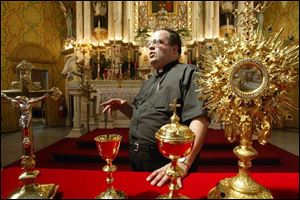
Mass no longer lost in translation
8/7/2004
Father Mark Borkowski describes the liturgical vessels in St. Josaphat Catholic Church. associated press The Missal, with its text in Latin, rests on the altar.
The language of the Roman Empire and the early Christian church again will echo through Detroit's historic St. Josaphat Church with the revival of a traditional form of the Latin Mass.
Detroit Roman Catholic Cardinal Adam Maida is reaching back 40 years to revive the Latin Mass as part of an effort to save a central city church that is struggling to retain its membership.
In Toledo, St. Joseph's Church at 628 Locust St. has celebrated a traditional Latin Mass for more than a decade, and many people are attached to its solemnity, the Rev. Stephen Majoros said.
"Every worship service of a public nature should give people a feeling of being in touch with God," he said.
Properly called the Latin Mass according to the 1962 Missale Romanum, the Mass at St. Joseph's is not identical to the Tridentine Mass that dates back to the 1500s.
"It's not quite the same, but it's close," Father Majoros said.
St. Joseph's celebrates Latin Mass every Thursday at 6 p.m., the second Sunday of the month at 8:30 a.m., and the last Sunday of the month at 11 a.m.
Mass, which derives from the Latin phrase "Ita, missa est" with which the priest dismisses parishioners at the end of worship, will be offered in Latin at St. Josaphat on Sunday mornings beginning Oct. 3.
"We're all hoping it will bring a lot of new people through our doors," Kevin Piotrowski, the 40-year-old head of the parish council, said.
The Second Vatican Council in the 1960s led to many liberalizing changes in the Mass, such as having priests face the congregation and celebrating the service in the local language rather than Latin.
Father Majoros said while the Latin language was required in seminary for centuries, there was a period when it was not taught.
"A number of current priests do not know Latin," he said.
But some Catholics have longed for a return to traditional forms of worship, in which "in nomine Patris et Filii et Spiritus Sancti" replaces "in the name of the Father,the Son and the Holy Spirit."
"We think there are a lot of Catholics who still want the older Mass," said St. Josaphat's pastor, the Rev. Mark Borkowski. "We think they'll come to St. Josaphat because we will have the only regular Tridentine Mass that's authorized by the Archdiocese of Detroit."
The Tridentine Mass is a traditional form of Catholic worship codified in 1570. Several other Detroit parishes offer regular Latin Masses, but they are Latin versions of the post-1960s Mass, the Novus Ordo. St. Joseph's is the only Toledo church that offers a Latin Mass.
At St. Josaphat, church officials are hoping that Catholics will drive a long way for the Tridentine Mass. During much of this Latin Mass, priests face an altar with their backs to the congregation.
"The priest and people together face the same direction, turning toward God," Father Majoros said.
He said modern church sanctuaries often make that difficult. As an example, he pointed out the renovation of St. Martin de Porres Catholic Church, in which the altar will be in the center of the sanctuary, with chairs surrounding it on all sides.
Father Majoros said people, including young families, come to St. Joseph's as an alternative to their regular parish Mass from as far away as Bellevue, Findlay, and Fayette.
"Sometimes people who do not have this attachment conclude that the 1962 ritual appeals only to old people, which is not true," he said.
Christine Scarlett of Maumee said her family, with seven children, ages 5 to 19, has attended St. Joseph's since 1995. Books at the church have the Latin and the English translation on the same page, making it easy to follow along, she said.
Several of the Scarlett children have studied Latin informally.
Mrs. Scarlett said the English translation is not the same as the modern English Mass.
"It's much more reverent," she said. "I think there's a holy mystery about it."
The Associated Press contributed to this report.